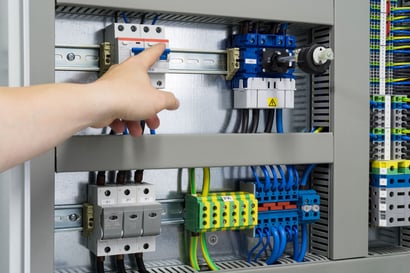 The protection provided by a surge protector on your system and its devices is essential, as surge events are unpredictable and can damage or even destroy equipment essential to your system’s operation. However, there are several common problems that may occur during the installation of a surge protection device (SPD) that will prevent it from giving you the protection you need. There are ways to ensure that you are getting the proper surge protection from your SPD, even after you have installed it on your system.
The protection provided by a surge protector on your system and its devices is essential, as surge events are unpredictable and can damage or even destroy equipment essential to your system’s operation. However, there are several common problems that may occur during the installation of a surge protection device (SPD) that will prevent it from giving you the protection you need. There are ways to ensure that you are getting the proper surge protection from your SPD, even after you have installed it on your system.
While many SPDs are designed with no easy visual indicator that they are working, SPDs from leading manufacturers often provide a visual indication when replacement is required. The downside is that normally you have to make a physical inspection to see this indication. The most common indicator is one or more LED lights installed for this purpose; when lit, they confirm normal operation and protection. A low-voltage surge protector will either short to ground or open the circuit, depending on the specific design of the device, when it has done its job and sacrificed itself to protect your equipment. When that happens, the LED indicator light will turn off, signaling that the SPD requires replacement. Ensure that you have installed your surge protector correctly and quickly replace it when one or more damaging surge event has worn the device out.
There are a myriad of common errors that can prevent proper installation of a surge protective device, but improper grounding is the root of most installation issues with SPDs. The absolute
minimum wire distance on which a surge protector should be placed is 3 feet, to ensure that the surge protection device has time to react and dissipate the charge. A longer wire distance will give the device more time to perform the dissipation. Often a device is installed in the most convenient location near the equipment it is protecting, and the lead length is not long enough to allow the device to perform properly. Ensure that your device is installed with a proper lead.
For example, if you are installing your surge protector on an IP camera mounted to a pole, it is not best practice to put your surge protection device up near the location of the camera. Placing the device at the base of the pole gives the proper lead length to dissipate the charge, and a shorter distance to the ground in order to send the charge elsewhere. Though it may seem like your surge protector will protect your camera better if it is nearby, a well-grounded device with proper lead length is a protector that is able to function properly.
Installation shortcuts can impede the functionality of your surge protector. Chaining multiple ground wires together or adding twist-on wire-connectors, or ‘wire nuts’, can add resistance and impedance to the grounding path. Wire nuts, additionally, may become loose or corroded over time, and can increase the resistance of the grounding conductor unnecessarily. Ensure that your surge protection is installed with a grounding bus bar to terminate ground wires to existing leads.
Installation issues are not the only possibility for the cause of improper surge protection on your critical equipment. Manufacturer standards are often a great resource to corroborate that you are installing the surge protection your equipment requires, and that the surge protection is being installed using best practices. The Institute of Electrical and Electronics Engineers (IEEE), has a ‘trilogy’ of standards that can provide installation guidelines for location, level of exposure, and voltage. By comparing with the manufacturer’s standards for surge protection, you can ensure that the protection you install on your critical systems is specific to the devices you need to protect.
Surge protection is essential to maintaining the life of your electrical equipment, but installing a surge protector in and of itself does not ensure the proper protection. Installations are often done improperly, and surge protectors can come in a variety of styles that may not be what your system requires. Keep your critical systems working by properly replacing surge protection that has been destroyed in a damaging surge event, installing new devices with proper grounding procedures, and making sure that your surge protection devices are properly matched with the systems they are protecting. Keeping your system from damage and downtime is crucial-- ensure that you’re properly protected.


.png?width=58&height=58&name=X_logo_2023_(white).png)
